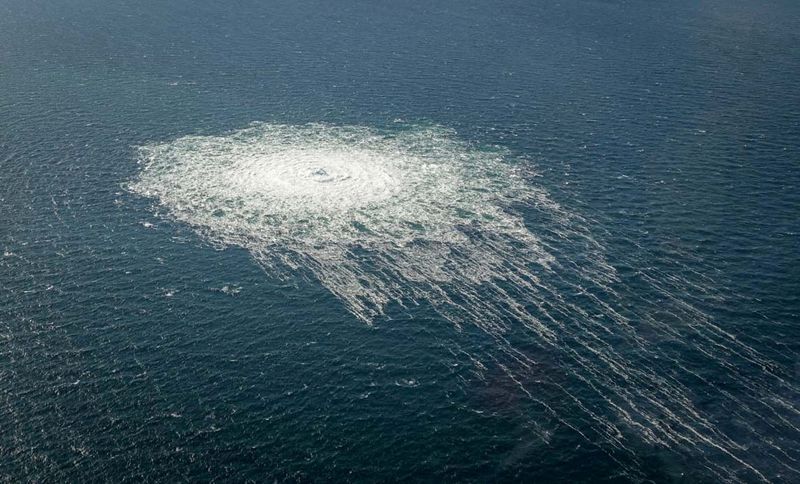[ad_1]

© Reuters. FILE PHOTO: Gas bubbles from the Nord Stream 2 leak reaching surface of the Baltic Sea in the area shows a disturbance of well over one kilometre in diameter near Bornholm, Denmark, September 27, 2022. Danish Defence Command/Handout via REUTERS
By Johan Ahlander
STOCKHOLM (Reuters) -A state actor’s involvement in the blast of the Nord Stream pipelines last year is the “absolute main scenario”, though confirming identity will prove difficult, the Swedish prosecutor investigating the attack said on Thursday.
In September 2022, several unexplained underwater explosions ruptured the Nord Stream 1 and newly-built Nord Stream 2 pipelines that link Russia and Germany across the Baltic Sea. The blasts occurred in the economic zones of Sweden and Denmark and both countries say the explosions were deliberate, but have yet to determine who was responsible.
The blast in the Swedish zone occurred at a depth of 80 meters, which the Swedish prosecutor said made it complicated to investigate.
“We believe it will be rather difficult to determine who did this,” prosecutor Mats Ljungqvist told Reuters in a phone interview.
“The people who did this have probably been aware that they would leave clues behind and probably took care so that the evidence would not point in one direction, but in several directions,” he added.
“That makes it difficult to clearly point to one actor.”
The investigation continues.
Russia’s invasion of Ukraine has put Europe’s reliance on Russian in the political spotlight and the destruction of the Nord Stream pipelines has hastened the bloc’s switch to other energy suppliers.
Nord Stream 1 and Nord Stream 2, each consisting of two pipes, were built by Russia’s state-controlled Gazprom (MCX:) to pump 110 billion cubic metres (bcm) of natural gas a year to Germany.
Ljungqvist said investigators had been able to determine what type of explosive had been used and that it ruled out “a very large number of actors”, but declined to name the explosive, citing the ongoing nature of the investigation.
While no conclusion has been drawn there have been a number of theories as to who blew up the pipelines and how.
Germany has confirmed its investigators raided a ship in January that may have been used to transport the explosives used to blow up the pipelines. German media reported the boat could have been used by a small Ukrainian or pro-Ukrainian group.
Ljungqvist said it could not be completely ruled out that an independent group, as opposed to a state actor, was behind the attack, but that it was unlikely.
“There are certain companies that have certain special missions that mean they could, in theory, carry this out,” he said. “We don’t rule out anything, but that it is a state actor who is directly or at least indirectly behind this is of course our absolute main scenario, given all the circumstances.”
U.S. journalist Seymour Hersch reported earlier this year that American authorities, with aid of the Norwegian military, were behind the attack.
Both the United States and Ukraine have denied having anything to do with the attacks as has Russia. Moscow, without providing evidence, has blamed the explosions on Western sabotage.
Ljungqvist said the incident had become an open arena for attempts to influence the hotly debated proceedings, likely with the purpose of deliberately sowing confusion.
“I don’t want to comment on any specific report but I can conclude that many of the hot theories can be easily ruled out based on what we know from the investigation,” he said.
[ad_2]
Source link
(This article is generated through the syndicated feed sources, Financetin doesn’t own any part of this article)
